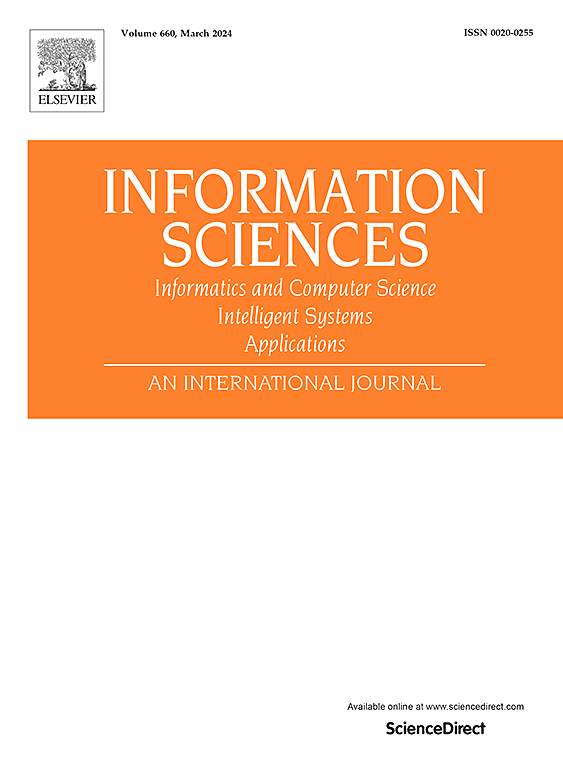A three-way efficacy evaluation approach with attribute reduction based on weighted temporal fuzzy rough sets
IF 8.1
1区 计算机科学
0 COMPUTER SCIENCE, INFORMATION SYSTEMS
引用次数: 0
Abstract
Precise evaluation of clinical efficacy is essential to promote the quality of treatment for patients. Accordingly, some techniques have been used to evaluate or predict the effect of treatment programs, such as statistics, machine learning, and granular computing. In contrast, granular computing can offer flexible, interpretable methods that do not require any prior knowledge to address complex efficacy evaluation problems from a data-driven perspective. Moreover, patients' efficacy information often alternates dynamically between improvement, deterioration, and no change. Granular computing-based methods provide a useful tool for the realization of three-way efficacy classification. Leveraging these advantages, this study attempts to construct a new decision-making approach over the framework of granular computing to deal with a class of efficacy evaluation problems with multi-granularity unbalanced temporal incomplete hybrid decision systems (MGUTIHDSs). To eliminate redundant attributes, we first put forward an attribute reduction method based on weighted temporal fuzzy rough sets. At the same time, several relevant properties are explored. Then, we devise a three-way efficacy evaluation model to objectively complete the personalized evaluation of previous treatment programs. Notwithstanding, it is not feasible to evaluate the efficacy of treatment programs taken at the current time node. To address this issue, a neighborhood-based average similarity prediction method is further developed. Consequently, a three-stage approach including attribute reduction, efficacy evaluation, and efficacy prediction is presented to achieve the efficacy classification of all treatment programs. Finally, the suitability and effectiveness of the approach are demonstrated by a real case study of rheumatoid arthritis. The comparison results indicate that our approach has superior performance, which can provide effective decision support for clinical practice.
一种基于加权时间模糊粗糙集的属性约简三向效能评价方法
准确评价临床疗效对提高患者的治疗质量至关重要。因此,一些技术已被用于评估或预测治疗方案的效果,如统计学、机器学习和颗粒计算。相比之下,颗粒计算可以提供灵活、可解释的方法,这些方法不需要任何先验知识,就可以从数据驱动的角度解决复杂的疗效评估问题。此外,患者的疗效信息经常在改善、恶化和无变化之间动态变化。基于颗粒计算的方法为实现三方面功效分类提供了一个有用的工具。利用这些优势,本研究试图在颗粒计算框架上构建一种新的决策方法来处理一类多粒度不平衡时间不完全混合决策系统(mgutihds)的功效评估问题。为了消除冗余属性,首先提出了一种基于加权时态模糊粗糙集的属性约简方法。同时,对相关性质进行了探讨。然后,我们设计了一个三方疗效评价模型,客观地完成对以往治疗方案的个性化评价。尽管如此,评估在当前时间节点所采取的治疗方案的疗效是不可行的。为了解决这一问题,进一步提出了基于邻域的平均相似度预测方法。因此,提出了属性约简、疗效评价和疗效预测三阶段的方法来实现所有治疗方案的疗效分类。最后,通过类风湿性关节炎的实际案例研究证明了该方法的适用性和有效性。结果表明,该方法具有较好的性能,可为临床实践提供有效的决策支持。
本文章由计算机程序翻译,如有差异,请以英文原文为准。
求助全文
约1分钟内获得全文
求助全文
来源期刊

Information Sciences
工程技术-计算机:信息系统
CiteScore
14.00
自引率
17.30%
发文量
1322
审稿时长
10.4 months
期刊介绍:
Informatics and Computer Science Intelligent Systems Applications is an esteemed international journal that focuses on publishing original and creative research findings in the field of information sciences. We also feature a limited number of timely tutorial and surveying contributions.
Our journal aims to cater to a diverse audience, including researchers, developers, managers, strategic planners, graduate students, and anyone interested in staying up-to-date with cutting-edge research in information science, knowledge engineering, and intelligent systems. While readers are expected to share a common interest in information science, they come from varying backgrounds such as engineering, mathematics, statistics, physics, computer science, cell biology, molecular biology, management science, cognitive science, neurobiology, behavioral sciences, and biochemistry.
 求助内容:
求助内容: 应助结果提醒方式:
应助结果提醒方式:


